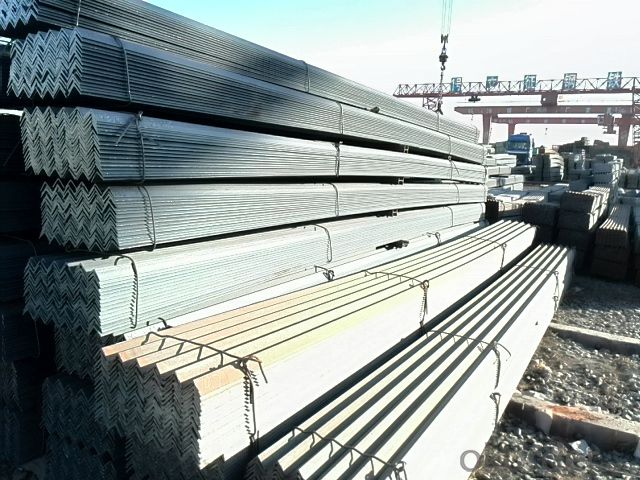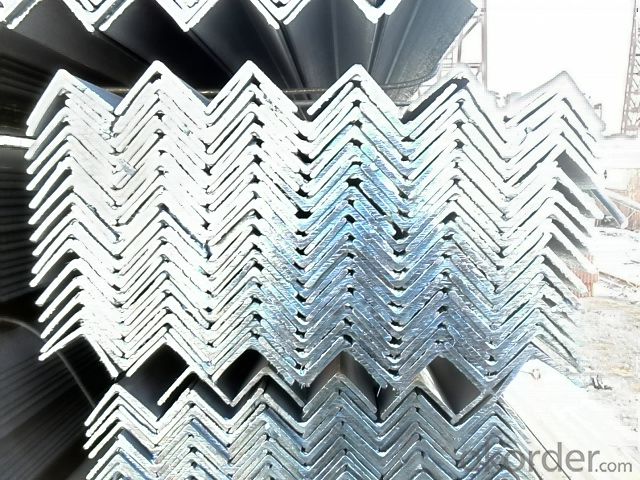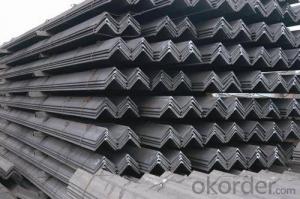Hot Rolled Steel Angle Bar with Best Price
- Loading Port:
- Tianjin
- Payment Terms:
- TT OR LC
- Min Order Qty:
- 25 m.t
- Supply Capability:
- 10000 m.t/month
OKorder Service Pledge
OKorder Financial Service
You Might Also Like
Item specifice
Okorder.com is a professional materials & equipment supplier & manufacturer, offers integrated one-stop services including real-time quoting and online cargo tracking. We are funded by CNBM Group, a Fortune 500 enterprise and the largest materials & equipment firm in China.
Product Applications:
According to the needs of different structures, Angle can compose to different force support component, and also can be the connections between components. It is widely used in various building structures and engineering structures such as roof beams, bridges, transmission towers, hoisting machinery and transport machinery, ships, industrial furnaces, reaction tower, container frame and warehouse etc.
Product Advantages:
OKorder's Steel Angles are durable, strong, and resist corrosion.
Main Product Features:
· Premium quality
· Prompt delivery & seaworthy packing (30-45 days after receiving deposit)
· Corrosion resistance
· Can be recycled and reused
· Mill test certification
· Professional Service
· Competitive pricing
Product Specifications:
1. Invoicing on theoretical weight or actual weight as customer request
2. Length: 6m, 9m, 12m as following table
3. Sizes

Sizes: 25mm-250mm | ||
a*t | ||
25*2.5-4.0 | 70*6.0-9.0 | 130*9.0-15 |
30*2.5-6.6 | 75*6.0-9.0 | 140*10-14 |
36*3.0-5.0 | 80*5.0-10 | 150*10-20 |
38*2.3-6.0 | 90*7.0-10 | 160*10-16 |
40*3.0-5.0 | 100*6.0-12 | 175*12-15 |
45*4.0-6.0 | 110*8.0-10 | 180*12-18 |
50*4.0-6.0 | 120*6.0-15 | 200*14-25 |
60*4.0-8.0 | 125*8.0-14 | 250*25 |
4.Material details:
Alloy No | Grade | Element (%) | |||||
C | Mn | S | P | Si | |||
Q235 | B | 0.12—0.20 | 0.3—0.7 | ≤0.045 | ≤0.045 | ≤0.3 | |
Alloy No | Grade | Yielding strength point( Mpa) | |||||
Thickness (mm) | |||||||
≤16 | >16--40 | >40--60 | >60--100 | ||||
≥ | |||||||
Q235 | B | 235 | 225 | 215 | 205 | ||
Alloy No | Grade | Tensile strength (Mpa) | Elongation after fracture (%) | ||||
Thickness (mm) | |||||||
≤16 | >16--40 | >40--60 | >60--100 | ||||
≥ | |||||||
Q235 | B | 375--500 | 26 | 25 | 24 | 23 | |
FAQ:
Q1: Why buy Materials & Equipment from OKorder.com?
A1: All products are carefully selected from China's most reliable manufacturing enterprises. Through its ISO certifications, OKorder.com adheres to the highest standards and a commitment to supply chain safety and customer satisfaction. We can guarantee the quality!
Q2: The products are invoicing on theoretical weight or on actual weight?
A2: We can do it in both manners, it’s according to buyer's requirement.
Q3: Can fit in the containers of 20fts for 6M long ?
A3: Yes, we can put them into the containers in the form sideling, in this way we can save the buyer much ocean freight.
Images:


- Q:What is the difference between hot-rolled and cold-rolled steel angles?
- The main difference between hot-rolled and cold-rolled steel angles lies in the manufacturing process. Hot-rolled steel angles are formed at high temperatures, making them less precise in terms of dimensions and surface finish. Cold-rolled steel angles, on the other hand, are formed at room temperature, resulting in more precise dimensions and a smoother surface finish. Additionally, hot-rolled steel angles are generally more cost-effective, but cold-rolled steel angles offer improved strength and durability.
- Q:Can steel angles be used in architectural lighting installations?
- Yes, steel angles can be used in architectural lighting installations. Steel angles provide structural support and can be used to mount lighting fixtures securely. They are often used in applications where durability and strength are important, making them suitable for architectural lighting installations.
- Q:How do you calculate the shear capacity of a steel angle?
- To calculate the shear capacity of a steel angle, you need to consider the following factors: 1. Material properties: Determine the yield strength of the steel angle. This value represents the maximum stress the material can withstand before it starts to deform permanently. 2. Cross-sectional area: Measure the cross-sectional area of the steel angle. This involves calculating the width and thickness of the angle and multiplying them together. 3. Shear stress: Calculate the shear stress applied to the angle by dividing the applied force by the cross-sectional area. 4. Shear capacity: Compare the calculated shear stress to the yield strength of the steel angle. If the shear stress is lower than the yield strength, the angle is safe and can withstand the applied force. However, if the shear stress exceeds the yield strength, the angle may fail and deform. It is important to note that different design codes and standards may have specific equations or factors to consider when calculating the shear capacity of a steel angle. Consulting the relevant design code or seeking assistance from a structural engineer is recommended to ensure accurate and safe calculations.
- Q:What is the maximum cantilever length for a steel angle?
- Various factors, such as material strength, angle dimensions, and load requirements, influence the maximum cantilever length for a steel angle. Steel angles, commonly used as structural elements in construction, can be customized to accommodate different loads based on their size and configuration. In general, the ability of a steel angle to resist bending moments and deflection determines its maximum cantilever length. Bending moments occur when a load is applied to the free end of the cantilever, resulting in angle bending. Deflection refers to the degree of bending or sagging experienced under a specific load. Engineers rely on the moment of inertia, which measures the angle's resistance to bending, and the yield strength of the steel to establish the maximum cantilever length. The moment of inertia is impacted by the angle's dimensions, including flange width, flange thickness, and leg length. To ensure safety and compliance, it is crucial to adhere to project-specific design codes and standards. These guidelines outline the maximum allowable bending stress and deflection limits for steel angles under different loading conditions. To summarize, the maximum cantilever length for a steel angle is determined by factors such as material strength, dimensions, and load requirements. Calculation of the moment of inertia, consideration of yield strength, and compliance with relevant design codes and standards are essential steps in determining this length.
- Q:Can iron angle steel be welded with stainless steel angle steel?
- The best way is connected, steel angle iron punching stainless steel respectively. Use 8.8S high-strength screws to connect.
- Q:What are the different design considerations for steel angles in industrial buildings?
- Some of the key design considerations for steel angles in industrial buildings include the load-bearing capacity of the angles, the overall structural stability, the desired level of durability and resistance to corrosion, and the aesthetic appearance of the angles. Additionally, factors such as the specific application and function of the angles, the environmental conditions, and the available budget also play a role in determining the design considerations for steel angles in industrial buildings.
- Q:How many meters is one angle steel?
- According to the specification number, the selection range of the domestic angle iron is 3 - 9m, 4 - 12M, 4 - 19m, 6 - 19m four scopes. The length of Japanese steel angle is chosen from 6 to 15m.
- Q:How do steel angles perform under seismic loads?
- Steel angles are commonly used in construction to provide structural support and reinforcement. When subjected to seismic loads, steel angles have been found to perform exceptionally well due to their inherent properties and design flexibility. One key advantage of steel angles is their high strength-to-weight ratio. This allows them to withstand the intense forces and movements generated during an earthquake without significant deformation or failure. The compact shape of the angle also helps distribute the load more efficiently, minimizing stress concentrations and potential weak points. Moreover, steel angles can be easily connected to other structural elements, providing a robust and reliable connection system. This is particularly important in seismic design, where the ability to transfer forces and accommodate movements is essential. To further enhance their performance under seismic loads, steel angles can be designed with specific features. For instance, the addition of stiffeners or bracing elements can increase their resistance to lateral forces, reducing the risk of buckling or collapse. Additionally, the use of thicker and stronger steel grades can improve their overall capacity to absorb and dissipate seismic energy. Various seismic design codes and standards provide guidelines and requirements for the use of steel angles in seismic-resistant structures. These codes consider factors such as the maximum allowable stress levels, detailing requirements for connections, and the overall structural behavior under seismic actions. In conclusion, steel angles perform admirably under seismic loads due to their high strength-to-weight ratio, efficient load distribution, and flexibility in design. When properly designed and implemented, steel angles can effectively resist the forces and movements generated during an earthquake, ensuring the structural integrity and safety of the building.
- Q:Can steel angles be used for storage racks?
- Yes, steel angles can be used for storage racks. Steel angles are commonly used in the construction of storage racks due to their strength, durability, and ability to support heavy loads. They provide stability and structural integrity, making them suitable for storing various items in a safe and organized manner.
- Q:What are the load-bearing capacities of different steel angle sizes?
- The load-bearing capacities of various steel angle sizes differ based on multiple factors, such as the material grade, angle size, and angle length. Generally, larger steel angle sizes possess higher load-bearing capacities in comparison to smaller sizes. To determine the load-bearing capacity of a particular steel angle size, it is crucial to take into account its moment of inertia, which measures its resistance to bending. The moment of inertia increases as the angle size becomes larger, resulting in higher load-bearing capacities. Furthermore, the yield strength of the steel used in the angle also plays a significant role in determining its load-bearing capacity. Yield strength refers to the maximum stress that a material can endure without undergoing permanent deformation. Steel angles with higher yield strength can support heavier loads. To obtain accurate load-bearing capacity information for different steel angle sizes, it is important to consult engineering resources such as steel design manuals or structural engineers. These resources provide tables and formulas that consider the specific dimensions and properties of the angle, allowing for the calculation of the maximum allowable load it can safely bear. In conclusion, the load-bearing capacities of various steel angle sizes depend on factors including angle size, material grade, and yield strength. It is necessary to consult reliable engineering resources to obtain accurate load-bearing capacity information for specific steel angle sizes.
1. Manufacturer Overview |
|
|---|---|
| Location | |
| Year Established | |
| Annual Output Value | |
| Main Markets | |
| Company Certifications | |
2. Manufacturer Certificates |
|
|---|---|
| a) Certification Name | |
| Range | |
| Reference | |
| Validity Period | |
3. Manufacturer Capability |
|
|---|---|
| a)Trade Capacity | |
| Nearest Port | |
| Export Percentage | |
| No.of Employees in Trade Department | |
| Language Spoken: | |
| b)Factory Information | |
| Factory Size: | |
| No. of Production Lines | |
| Contract Manufacturing | |
| Product Price Range | |
Send your message to us
Hot Rolled Steel Angle Bar with Best Price
- Loading Port:
- Tianjin
- Payment Terms:
- TT OR LC
- Min Order Qty:
- 25 m.t
- Supply Capability:
- 10000 m.t/month
OKorder Service Pledge
OKorder Financial Service
Similar products
New products
Hot products
Hot Searches
Related keywords




























